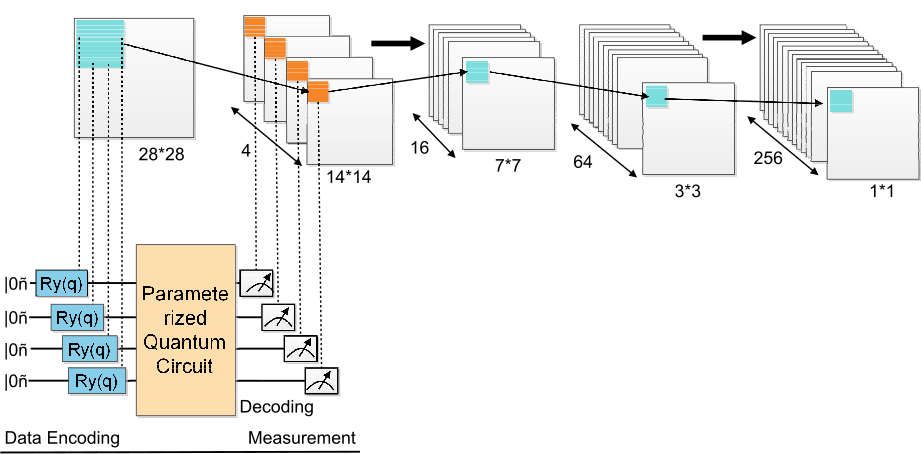Thanks for the submission! We hope you have enjoyed participating in QHack :smiley:
We will be assessing the entries and contacting the winners separately. Winners will be publicly announced sometime in the next month.
We will also be freezing the GitHub repo as we sort through the submitted projects, so you will not be able to update this submission.
Team Name:
QTechnocrats
Project Description:
Project Name - Analysis, Prediction and Evaluation of Covid-19 Datasets using Quanvolutional Neural Network
Dataset used -
We have used this datset from Kaggle which contains 250 training and 65 testing images for our model.
Our Approach to the classifier-
Preprocessing the dataset -
Images given in the dataset is real life chest x-ray and is not previouly modified. So all have different dimensions. So we reduced all the image size to a specific dimension. It would be more convenient to fix the image size to 256x256 to keep most of the patterns intact. But due to some limitation in computational resources, in this demonstration we kept the size as 28x28. We will definitely try with 256x256 dimension, later as an extended version of this hackathon project. Initially the dataset is provided in a folder format where all images of each classes are put in different folders. We used this python script to convert those images to 28x28 using openCV library and finally saved in csv format. You can get here the train csv and test csv.
Applying Quanvolutional Layer -
We have extended the single layer approach of Quanvolutional Neural Network to multiple layers, to be exact 4 layers in our model. You can get the notebook here.
In case notebook doesn't render properly, you can see this pdf
Initially Each images has the dimension of (28x28x1) which is fed to the first Quanvolutional layer and converted to (14x14x4). The 2nd Layer converts it to (7x7x16), 3rd layer to (3x3x64) and finally the 4th and last layer converts each to a (1x1x256) dimensional data matrix.
Here although the parameters of the Quanvolutional Layer gates are uniformly randomized, We have considered the approach of training these parameters too and see if there is any improvement in the result later in the extended version of this project.
Classifier Model -
After the Quanvolutional layers, we have the classifier model. The classifier model consists of two subclassifiers each of which is a binary classifier. We dente those two by 'Model-1' and 'Model-2'.
Model-1 classifies between two classes - 'Normal Person' and 'Covid19/Viral Pnemonia'.
Model-2 classifies between two classes - 'Covid-19' and 'Viral Pneumonia'.
One important point to mention here, Intially we tried to use single model for multi class classification and result turned out to be quiet low. So the two model approach we considered as the final one.
Also Here the accuracy of Model-1 is always higher than model-2 because differentiating 'Noraml Person' vs "covid/Viral Pneumonia' is easier than differentiating between 'covid' vs 'Viral Pneumonia'.
We have created three notebooks for this, with three different apprroach to the feature size reduction technique and the feature map circuit design.
In Notebook-1 we have used 11 features from 256 feature sized input data, extracted by Principal Data Analysis. Here we achieved an accuracy of approx 49% to 50%.
In Notebook-2 we have reduced 256 features of each image to 4 using TruncatedSVD method. This gave us a little lower accuracy in the range of 43% to 45%.
In Notebook-3 we have reduced the data further to 2 features only. Unexpectedly this gave us the highest of all previous approached, 60% accuracy.
We have done this beacuse encoding 256 features to a quantum circuit is not a feasible approach. Also more importantly, Quantum circuit seems to be performing better with lesser number of features. So we should more focus on in future to to reduce feature size efficiently not affecting the data patterns overall.
Prediction
While Predicting, we first give input to the Model-1. If it predicts as Normal person, then it is the final prediction assigned to the input. If not, then we give the same input to Model-2 and it finally predicts whether the chest x-ray reveals the patients has Covid-19 or Viral Pneumonia.
Some room for improvement in the current version, that we will be working on in the extended version of this project -
The real x-ray images in the dataset is enough large to contain a lots of information. But due to lack of computational resources we reduced the size to 28x28 using openCV library, which may have suppressed a lot of important informations. Later we wil experiment with 256x256 dimensional image which will incrase the accuracy of the model.
Currently although after applying Quanvolution and flattening the data we had 256 features of each image, we used only 11 features, 4 features and 2 features in Notebook-1, Notebook-2 and Notebook-3 respectively by various feature size reduction method. We can try out with more features to experiment whether accuracy improves with higher dimensional data or Quantum computers work better with lesser number of features only.
All the four quanvolutional layers applied on the image data is using uniformly generated random parameters, which are not further trained. Later, we will experiment with training those quanvolutional layers too so that the modified dataset can contain much more data about the real images.
We will also include the training result and final accuracy of models trained on more accurate simulators and gradually will try executing these on real Quantum computers to get more realistic experimental data.
Presentation:
Here is the Slide Presentation of Overall Project concepts. This ReadMe fille also consists of a lots of in depth discussion about our project.
Source code:
Here all the source code written till now for our project can be accessed in form of Jupyter notebook.